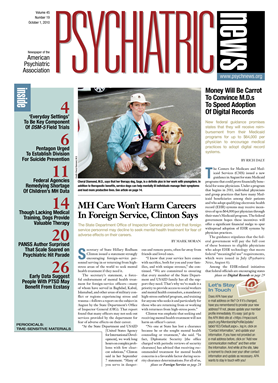Once used in clinical research only, psychiatric rating scales are increasingly becoming part of the clinician's armamentarium to assess a patient's progress objectively.
In the current health care climate, insurers want proof that an intervention is working, and “as an EKG serves a cardiologist, so does a clinical rating scale serve a psychiatrist,” said Lewis Opler, M.D., Ph.D., one of the two living developers of the Positive and Negative Syndrome Scale (PANSS).
Opler, a professor of clinical psychiatry at Columbia University Medical Center, began developing the PANSS in 1980 while an assistant professor of psychiatry at the Albert Einstein College of Medicine. Opler, just having completed his residency at Einstein, was studying the effects of L-dopa on tardive dyskinesia and unexpectedly saw the affect and social functioning of several patients improve when placed on L-dopa.
“At first I did not understand how this could be; then in 1980 I read a paper by Timothy Crow and his description of schizophrenia as being composed of at least two independent syndromes—type 1, or positive symptoms, and type 2, or negative symptoms.”
This made Opler wonder if L-dopa was improving negative symptoms. “The PANSS was really a result of a chance observation in my patients that led me, with the help of a brilliant psychometrician named Stanley Kay, to operationalize a way of making changes in positive, negative, and other symptoms. With our background as clinicians with training in research methodology, we developed the objective measure so it could be user friendly,” said Opler.
The need to evaluate the change in negative symptoms had become the spark that ignited the creativity of Opler and colleagues and that led them to develop the PANSS. Opler could never have predicted that the PANSS would be translated into more than 50 languages and used worldwide as a leading symptom severity rating scale for patients with schizophrenia and other psychotic disorders.
Before the use of rating scales, clinical judgment alone was used to determine whether a new medication was effective. The limits of subjective evaluations are of particular concern for patients switching providers, either due to insurance requirements or location of community providers.
“The PANSS allows the clinician to record the speed and degree of response and to compare the patient's course of illness with that seen previously,” said Opler. “Some clinicians think the PANSS was developed only for researchers. Once trained, clinicians are surprised at how easy it is to administer and score.”
To introduce the use of scales into clinical practice, Opler suggested that “the patient needs to be part of the team.” When explaining the rationale for this process to patients, he said, psychiatrists should “use terms that are familiar such as, ‘Just as internists check your blood pressure to see if treatment is working, some of us in psychiatry find it helpful to use this scale (PANSS or other) to get an objective reading of progress. If no changes are seen with current treatment, then we need to set a different course to be sure there is improvement.’”
Opler is an advocate for sharing the changes seen in rating scales with patients. However, he cautioned that the PANSS score should be used in addition to the clinical impression, not as a substitute for clinical judgment.
The PANSS has kept up with the quick pace of change of mental health care delivery. With the emergence of more Assertive Community Treatment teams, the utility of the PANSS becomes even more relevant to community outreach.
“At Columbia, where much research has been done on homelessness and its prevention in persons with schizophrenia, the PANSS has been the rating scale we've used, so it lends itself to community outpatient programs too,” noted Opler.

